To identify the correct hinge to install on a door and ensure its efficient functioning, there are various factors to be taken into consideration. The following recommendations are meant to highlight some crucial points to focus attention on and to explain some of the involved principles.
INDEX
Video Vademecum
Door weight and dimensions
Door weight and dimensions determine the hinge selection.
The stress on the hinges is due to:
• Door weight [A]
• Door width [B]
• Hinge spacing [C]
NB: As the door weight or width increases, or as the hinge spacing decreases, the hinge is subjected to a greater stress.
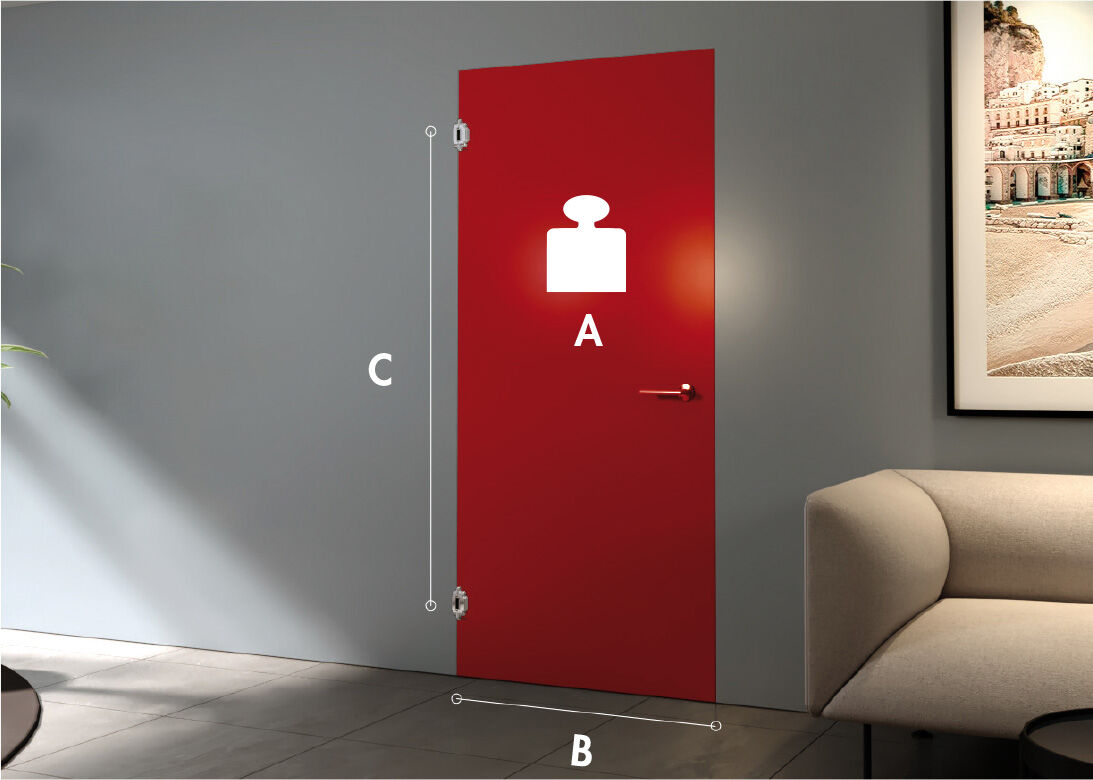
Position and distance between hinges
We define hinge spacing as the distance between the center of the top hinge and the center of the bottom hinge on the door leaf, whether or not there are other hinges between them.
NB: the hinge spacing influences the hinge load capacity. The smaller hinge spacing is, the lower hinge capacity is.
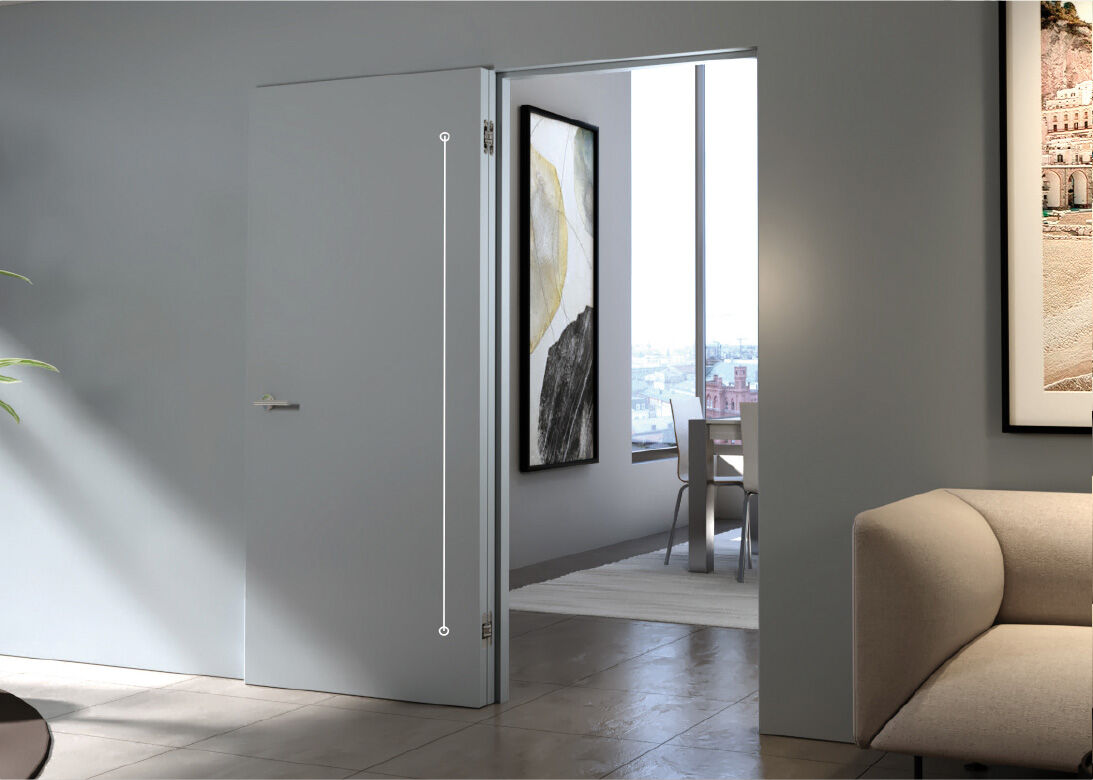
Hinge capacity table
It’s a reference table which determines the maximum hinge capacity based on the door width and hinge spacing.
NB: In order to maintain the load capacity, it may be required to increase the hinge spacing when the door leaf width is greater than the tested door dimension.
How to read the load capacity table
The Y axis indicates the distance between the hinges and the X axis indicates the door leaf width. By crossing the X and Y axes we get the hinge capacity.
The dimensions highlighted in green in the table below indicate combinations for which the hinge maintains its best performance. In this case capacity 60 kg with 2 hinges.
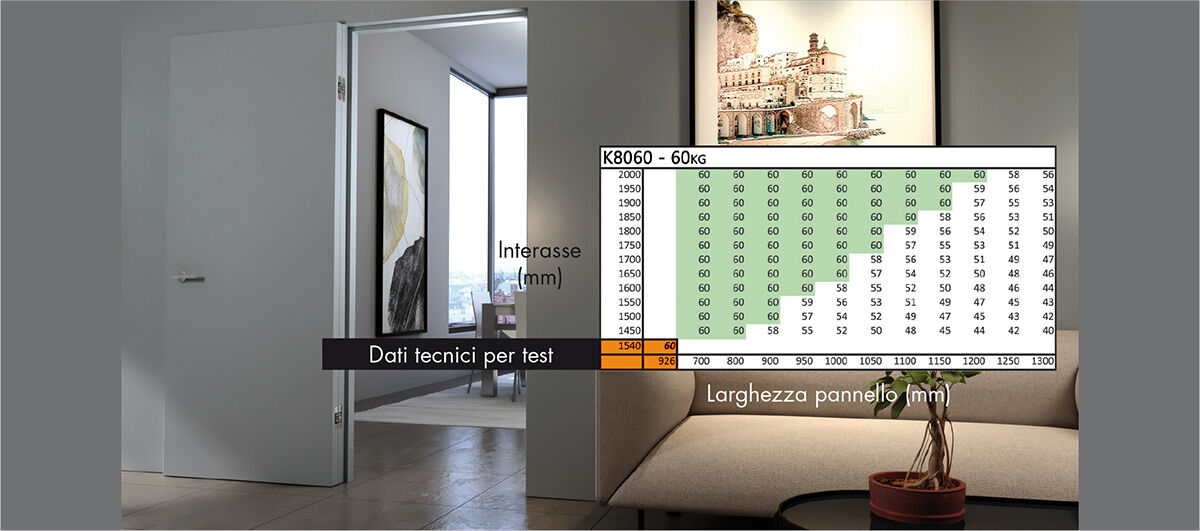
All Krona Koblenz hinges are tested on IFT certified test benches and according to EAD 020001-01-0405 standard. The data highlighted in orange (center distance, panel width and load capacity) show the characteristics used during the test.
Example of use to maximize the performance
Assuming the installation of 2 K8060 hinges in a door 2100 mm high, 900 mm wide and with a hinge spacing of 1500 mm, a load capacity of 60 kg would be reached.
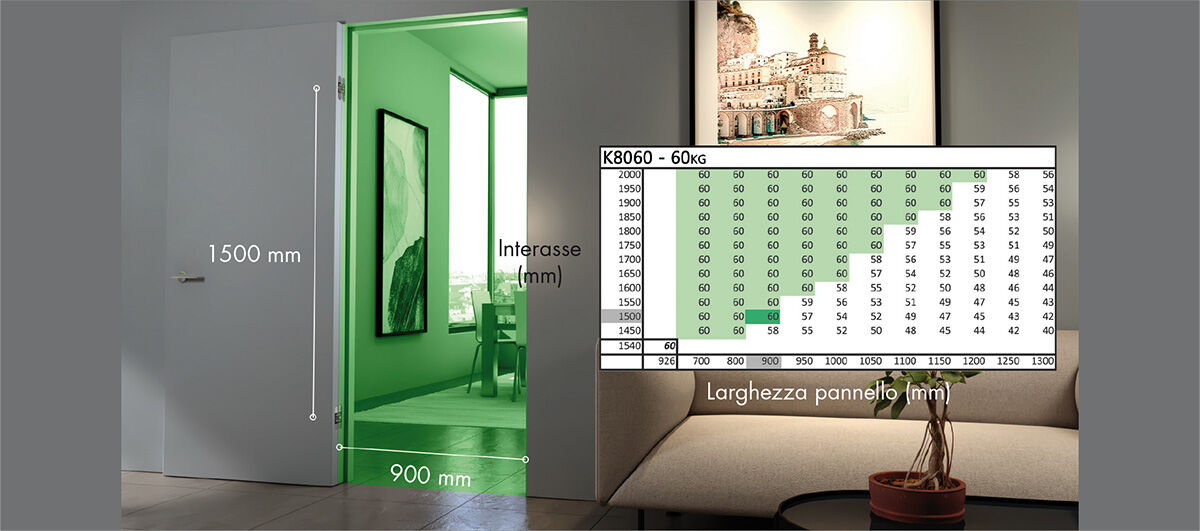
By increasing the door leaf width to 1000 mm (leaving the hinge spacing unchanged), the hinge load capacity drops to 54 kg.
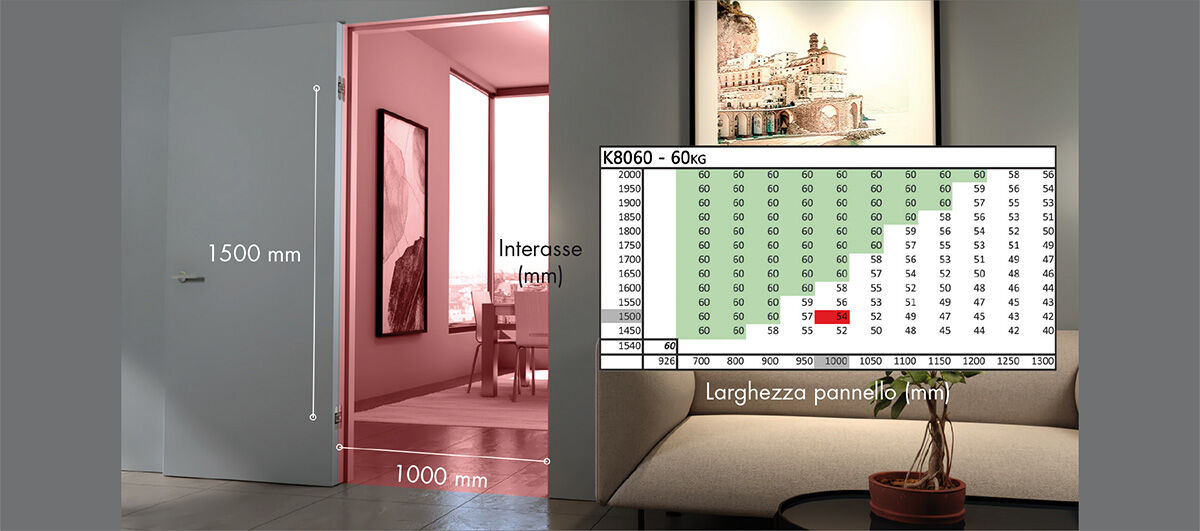
To obtain again a 60 kg capacity with a door leaf width of 1000 mm, it is necessary to increase the hinge spacing to at least 1650 mm. If the hinges are already placed at the far end of the door leaf, the load capacity will remain at 54 kg.
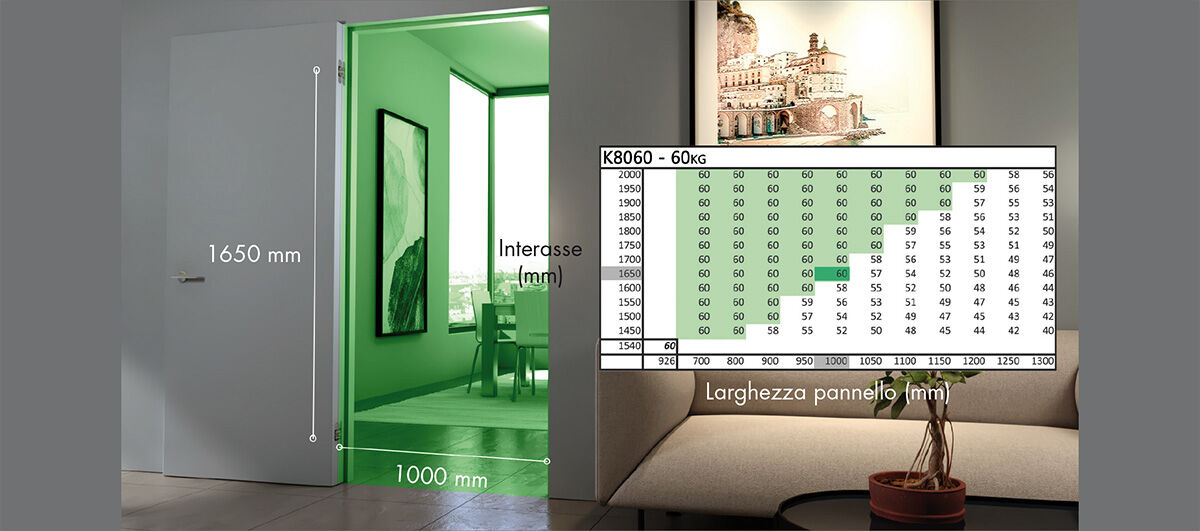
NB: Krona Koblenz always recommends increasing the hinge spacing for a minor door sagging over time and a greater hinge resistance.
How many hinges to install
Practical hints highlighting when to install 2, 3 or 4 hinges
2 hinges
For doors with a height of 2000-2100 mm and a width of up to 900 mm, the installation of 2 hinges is recommended.
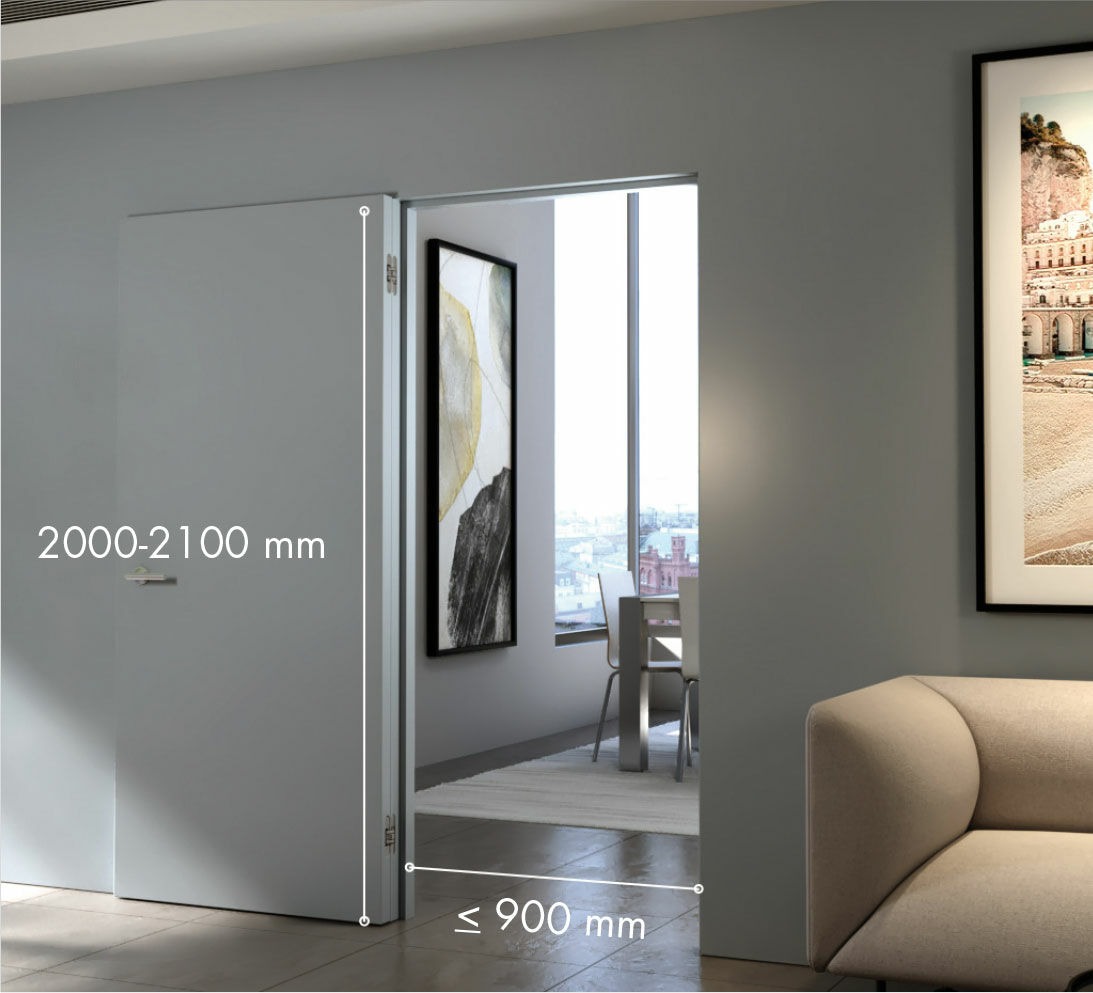
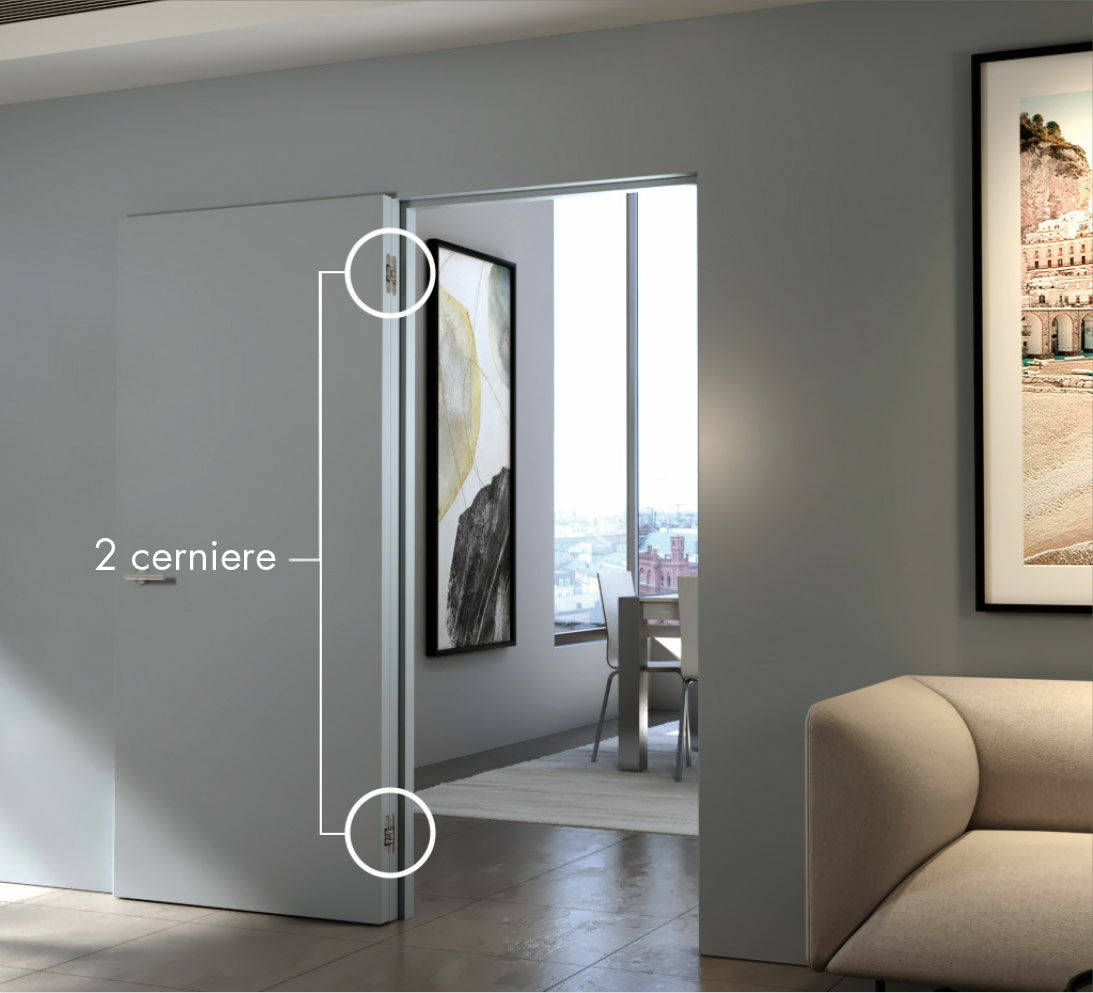
3 hinges
The use of 3 hinges is recommended in the following cases:
- doors higher than 2100 mm;
- doors to be installed in a damp environment;
- doors made of thin or light materials;
- door dividing spaces with very different temperatures.
The third hinge, to be installed in the centre, helps to keep the door leaf aligned.
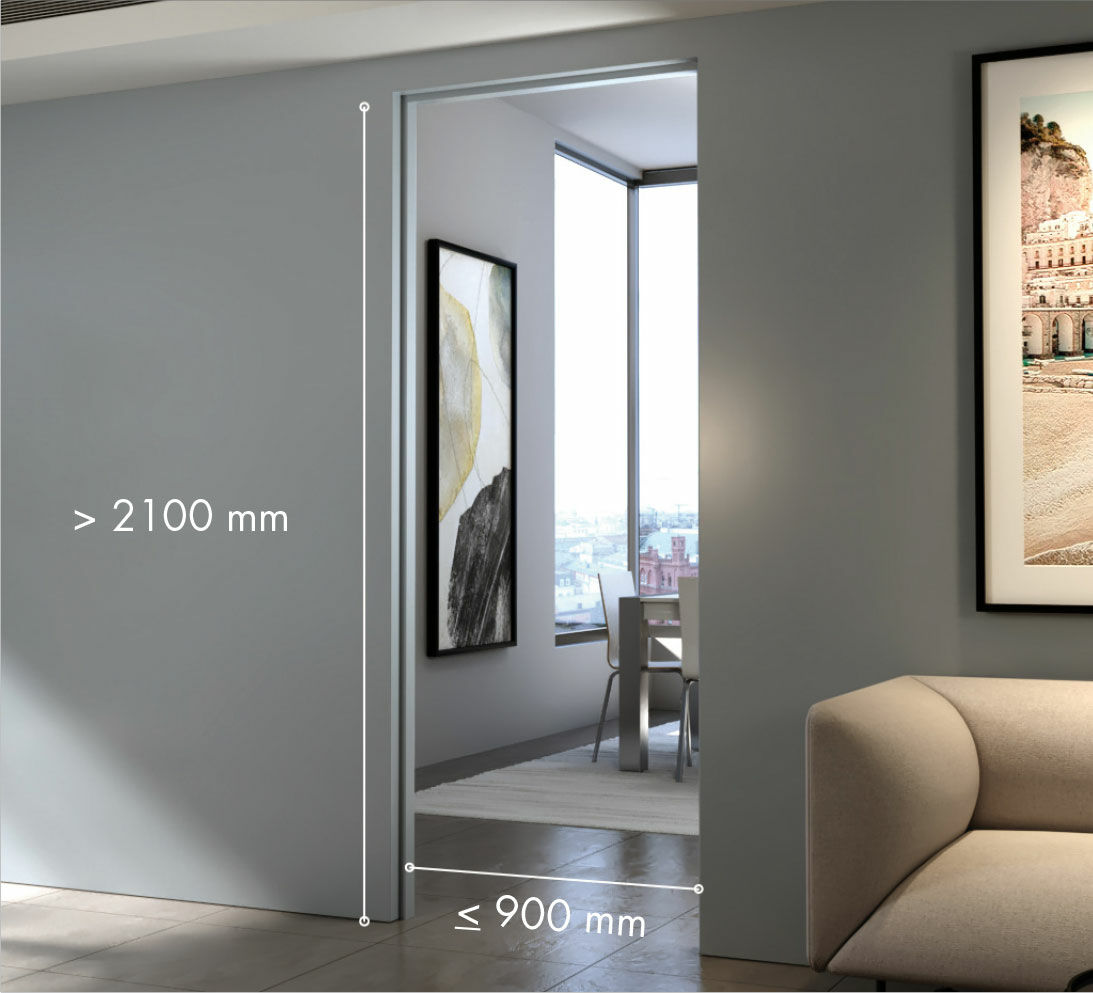
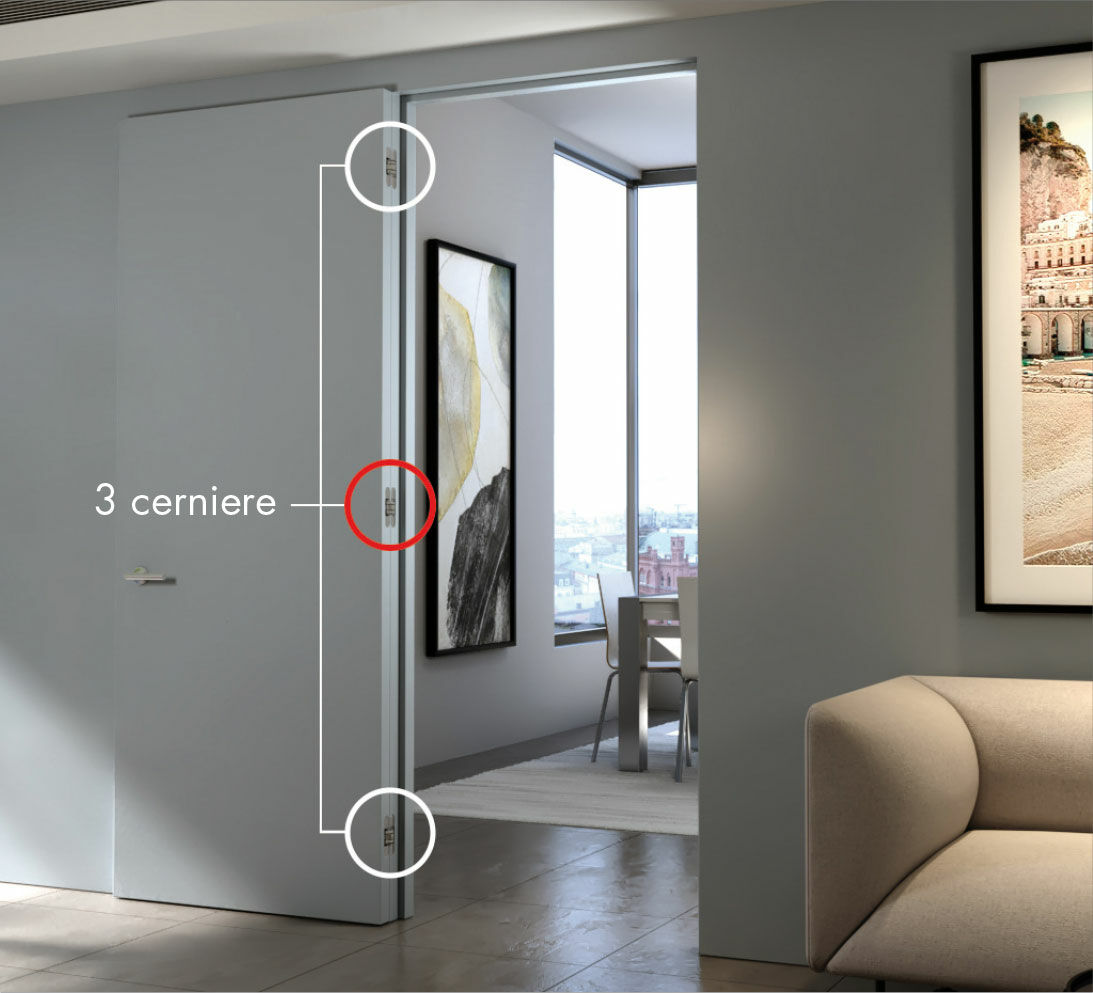
4 hinges
For doors higher than 2100 mm and with a width greater than 900 mm, or for installations in frequently visited public places (for example in schools, hospitals or airports), the installation of 4 hinges is recommended. The fourth hinge works as a support for the upper one, to be installed 250 mm away from the upper hinge.
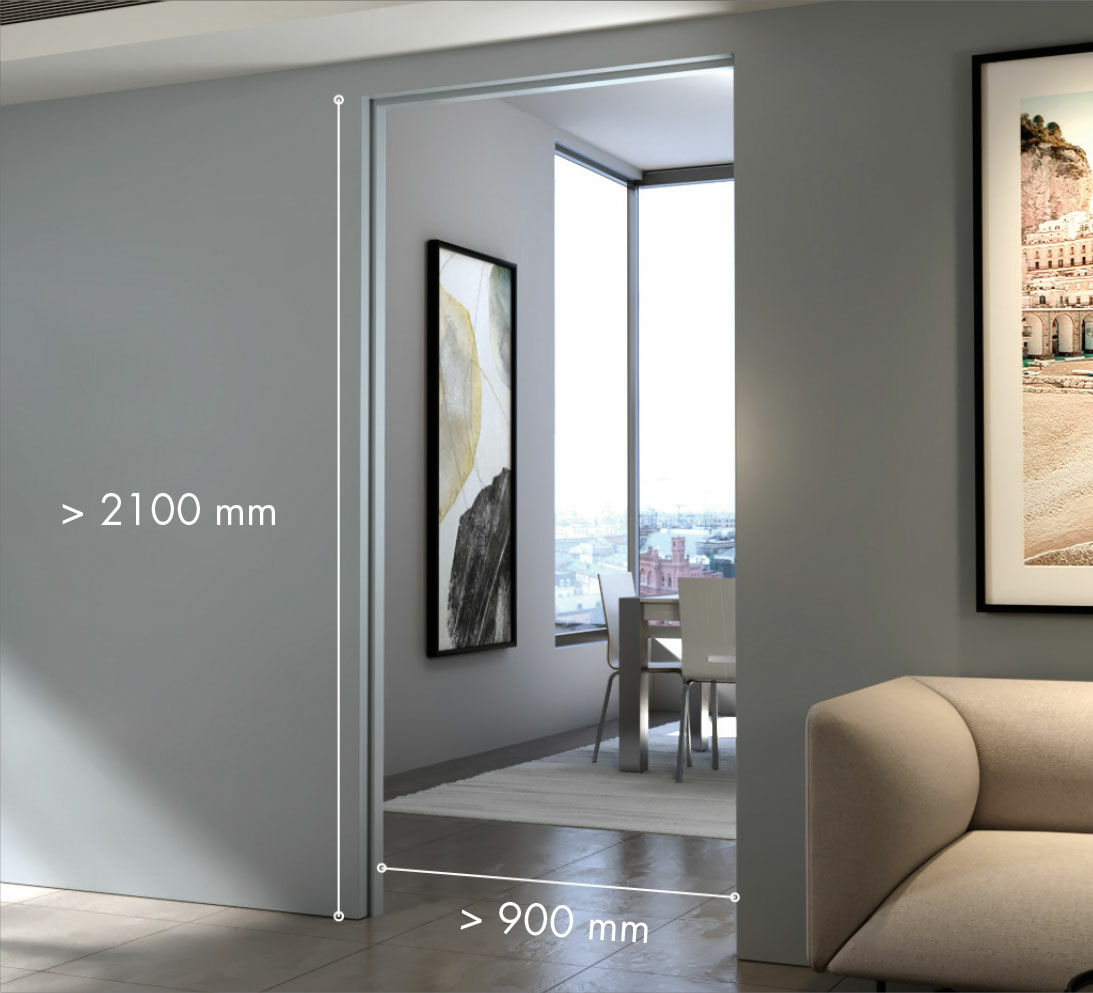
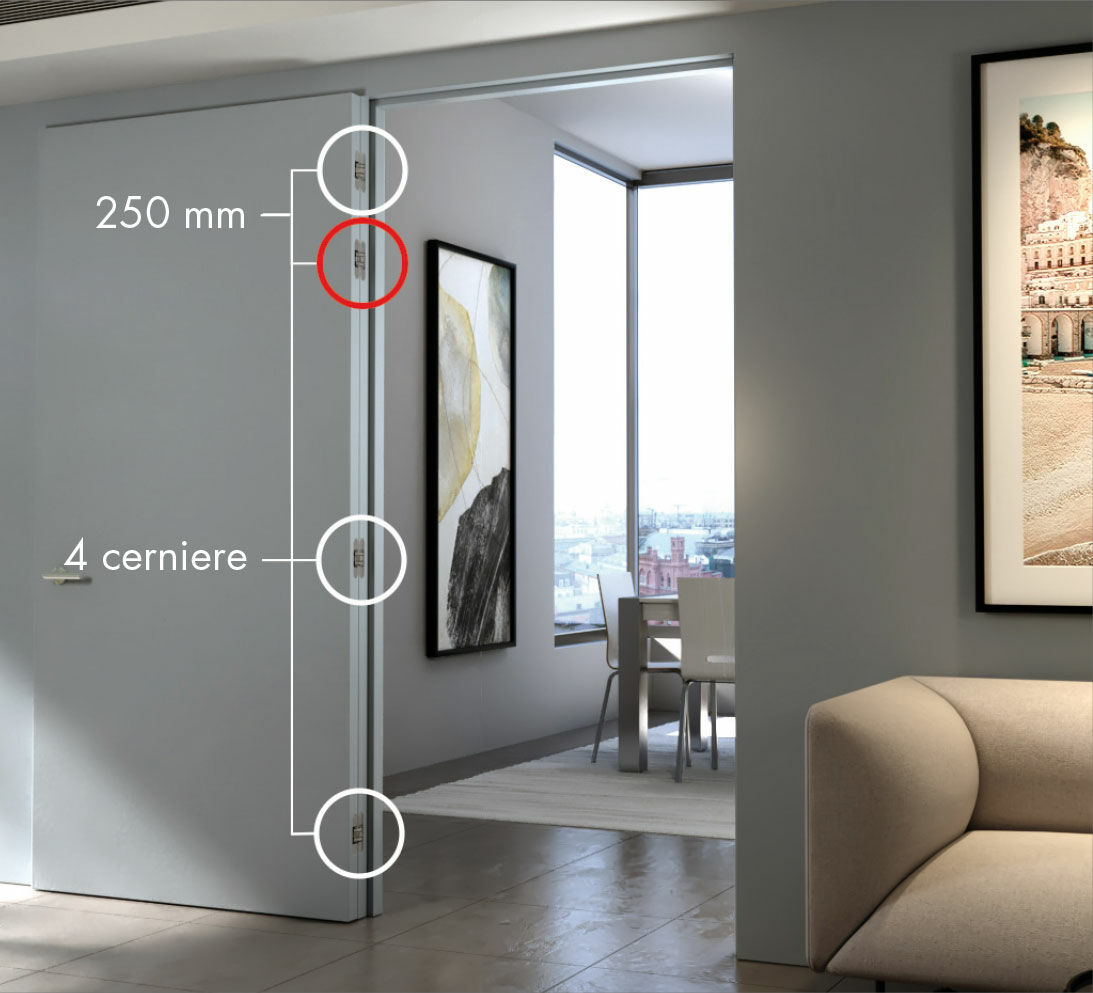
Accessories
The accessories we install on the door affect both the performance and the lifetime of the hinge. Below there are some examples of doors with accessories and their relative positioning.
Doors with top closers
If there is a door closer, 3 hinges are required. The third hinge acts as a support for the lower one, to be installed 250 mm away from the upper hinge.
NB: the recommended adjustment of the door closer must be just enough to make it work. The excessive force of the door closer could compromise the functioning of the hinges. Furthermore, if the installed door closer has the "opening limiter*" function, it must be deactivated to ensure the longer lifetime of the hinge.
*Opening limiter is a function of the door closer which allows you to limit the opening of the door to a smaller angle than the one the hinge would allow.
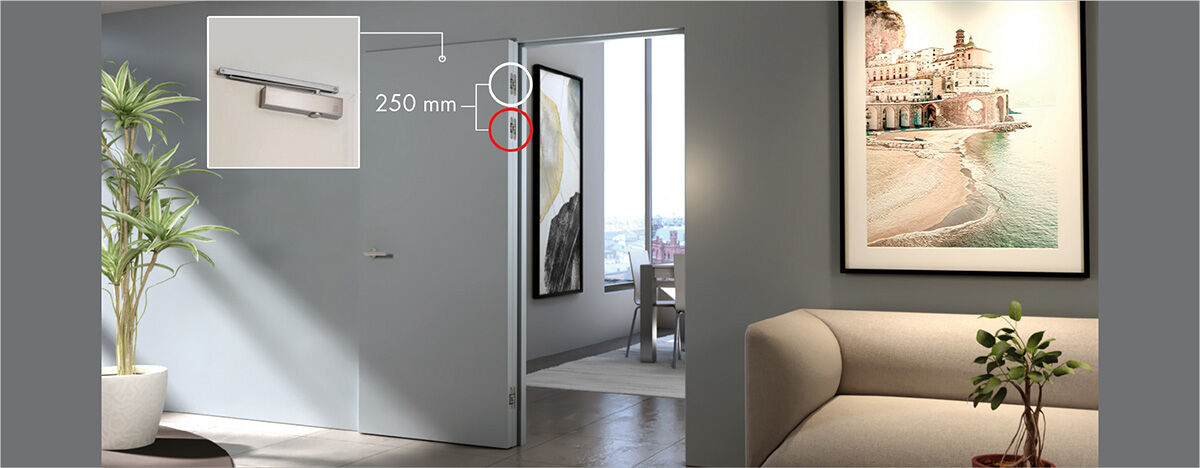
Doors with doorstops or dropdown seals
With one of these accessories, 3 hinges are required. The third hinge works as a support for the lower one, to be installed 250 mm away from the lower positioned hinge.
NB: the doorstop should be mounted as far away as possible from the door rotation axis. We recommend the installation at a distance of approximately 75% of the door width in the direction of the lock.
NB: the recommended dropdown seal setting must be just enough to make it work. Excessive pressure of the dropdown seal on the floor could compromise the work of the hinges.
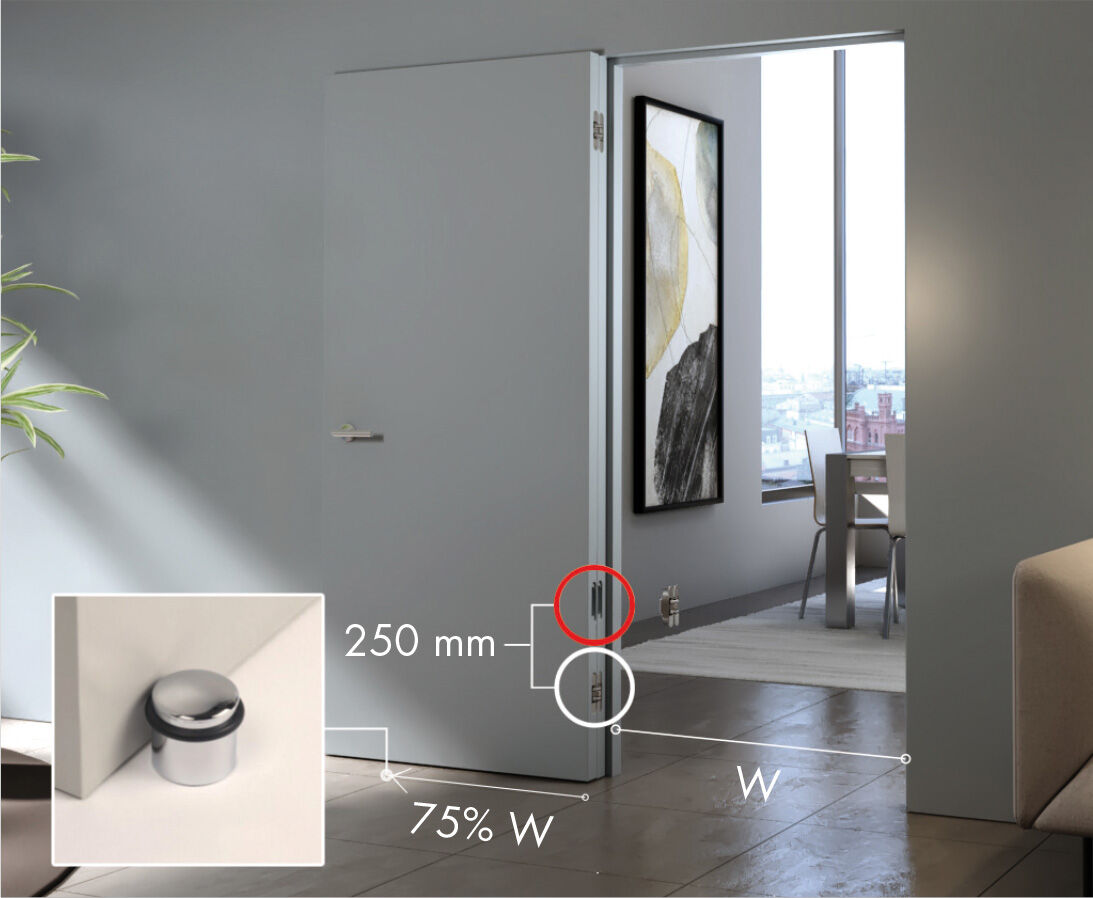
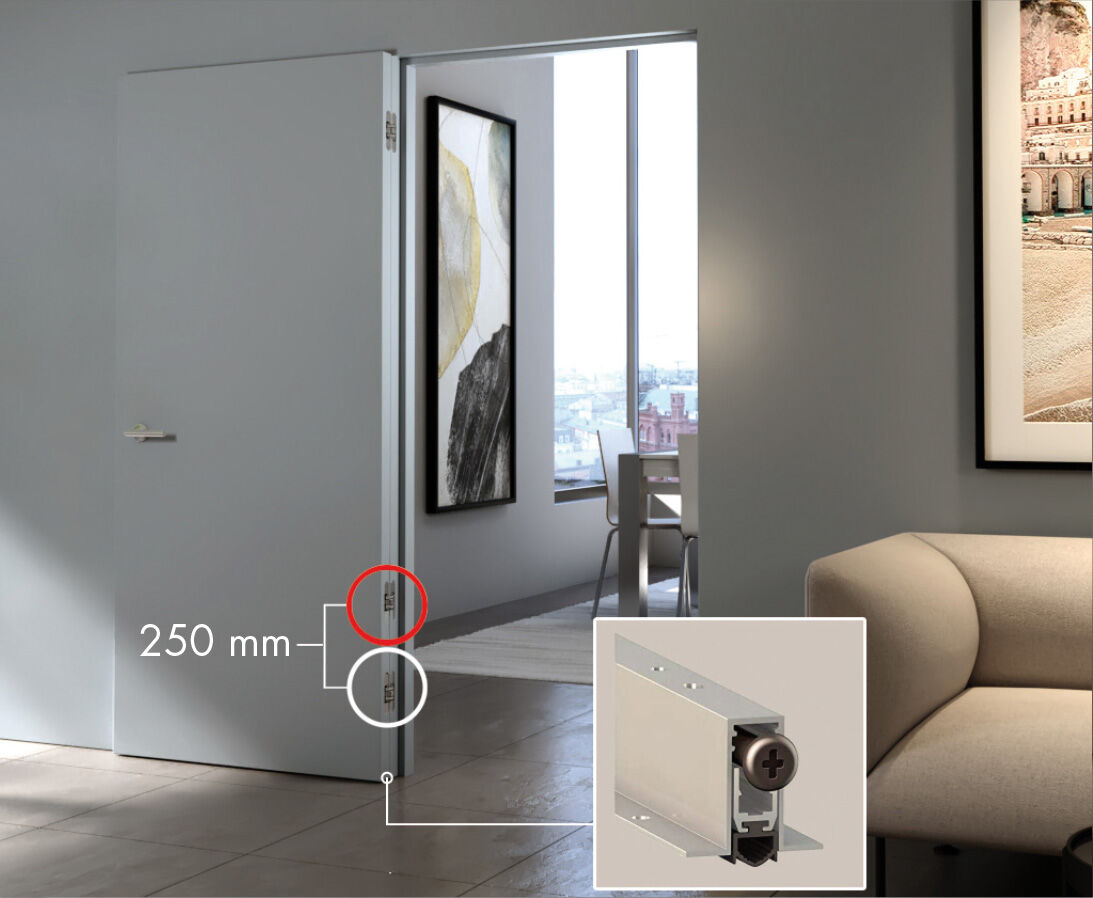
Door placing
There are 2 door placing types to be taken into consideration: public and private.
In buildings with a high public flow there is a high working intensity due to the frequent opening and closing. Even if the door weight does not require it, use the hinges with higher load capacity characteristics.

Insight
For more information on where the door is used, see the guide on the hinge classification table.
Link: https://www.kronakoblenz.com/en/product-school/guide-how-to-read-the-hinge-classification-key
Certifications
Our hinges are tested according to stringent tests that certify the product as fully compliant with the best performance parameters. They are therefore certified according to the most important standards governing construction products.
Based on performance and production processes, we have certified our products for: Fire Resistance, Functional Durability, Corrosion Resistance, CE and EPD.
Product tests
Fire tests
Tests carried out according to the reference standards for doors and closing systems which indicate fire resistance and smoke dispersion control. The acronym EI identifies a construction element which maintains, for a specific time "t", the resistance to flames, hot gases and thermal insulation.
Regulatory standards

EN 1634-1

BS476-22

ANSI/UL 10C

ANSI/UL 10B

CAN /ULC S104

GOST-R53307
Functional durability
Indicates the number of cycles, for which full operating efficiency is guaranteed.
The test involves moving a door weighing equal to the maximum capacity of a pair of hinges for a given number of cycles. At the end of the cycles, there must be no yielding beyond the limits indicated by the reference standard.
Regulatory standards

EN 1935

EAD 020001-01-0405

EN 1191
Corrosion resistance
It is a parameter that indicates, according to certain requirements, the degree of resistance to corrosion of door accessories. The parameter assumes particular importance in the environment with high atmospheric corrosion such as industrial or maritime one.
The European reference standard EN1670 requires the hinges to be subjected to a salt spray treatment for up to 240 hours.
Regulatory standards

EN 1670
CE MARK
It is a declaration of performance and constancy of performance according to the reference European standards for the product category.
The CE MARK implicitly declares that the product is provided with specific documents, regulatory tests, inspections the conformity of which has been ascertained by a notified body (IFT - Rosenheim).
Regular inspection by authorized certification bodies is necessary to maintain the CE mark and verify the conformity of production machines and processes.
Regulatory standards

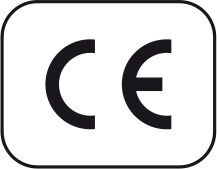
EOTA procedure as per
CPR introduced in 2013
Production process tests
EPD – Environmental Product Declaration

DIN ISO 14025
NB: the certification achieved by the hinge refers to the performance under the specific conditions. This means that a hinge certified for a capacity of 80 kg with the installation of 2 hinges will only be guaranteed by the certification for a capacity of 80 kg even if a third hinge is installed to try to increase the overall capacity.
REGULATORY BODIES

TEST BENCH FOR DURABILITY TRIAL
The attention we pay to the reliability of the hinges has led us to install test benches, including one certified by IFT, which we use to test ALL the hinges for multiple durability tests in accordance with the Test protocol specified by the regulations EAD_020001-01- 0405, EN1935 and/or EN1191.
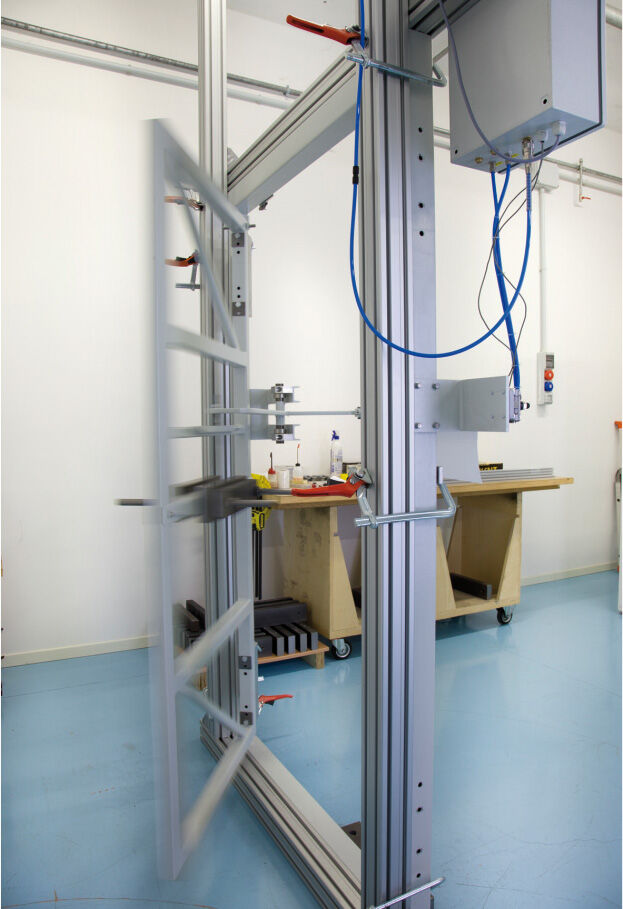
Warnings and recommendations
To ensure proper functioning of the hinge, it is essential to carefully assess all details of the door and the frame on which it will be mounted.
See our guide 'Warnings and Recommendations'.
Link: https://www.kronakoblenz.com/en/product-school/warnings-and-recommendations-hinges
Do you think concealed hinges could be the solution for your project?
